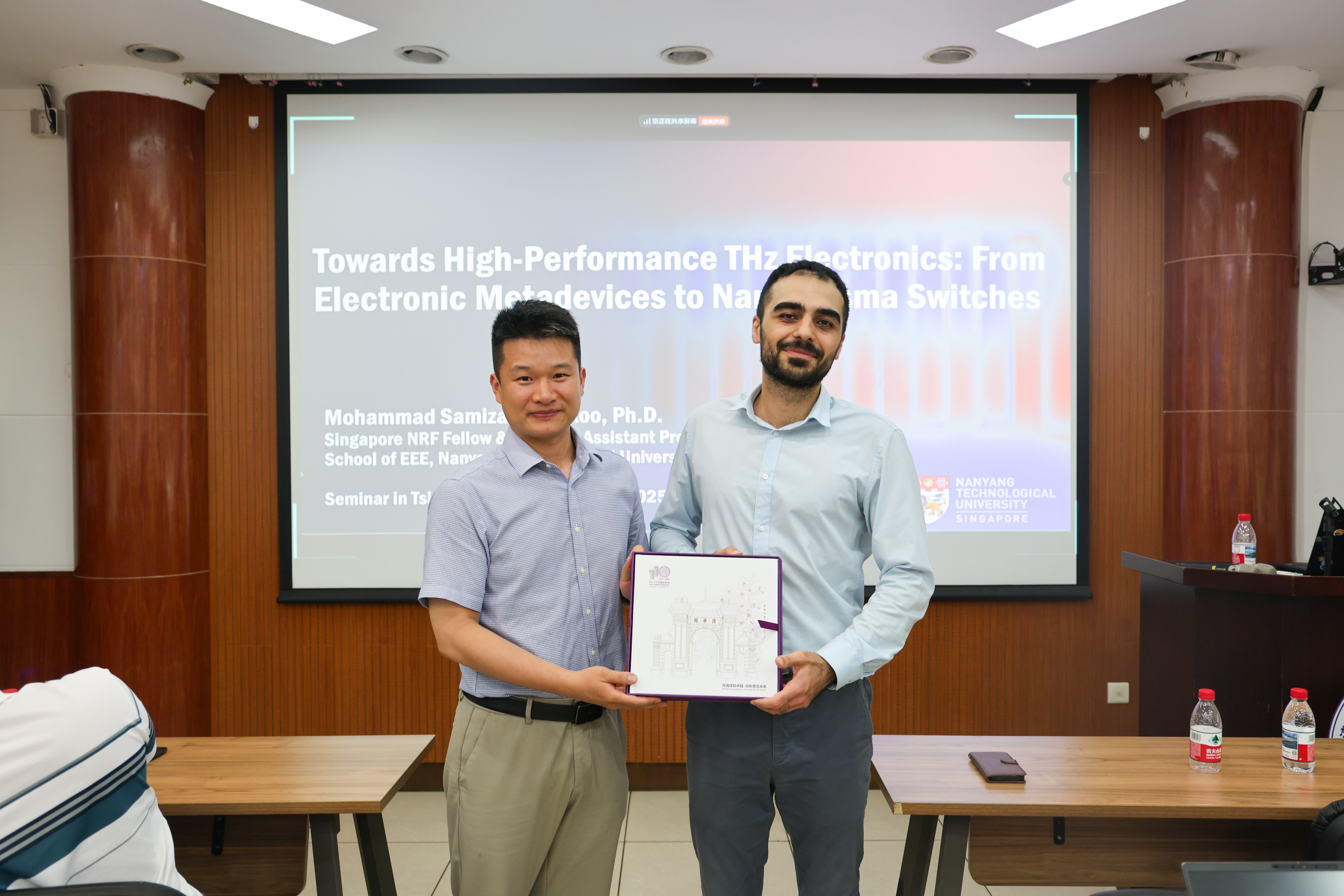On July 25, Professor Mohammad S. Nikoo from the School of Electrical and Electronic Engineering, Nanyang Technological University (NTU), Singapore, visited the Department of Electrical Engineering and Applied Electronics (EEA), Tsinghua University at the invitation of Associate Professor Fu Yangyang, and delivered an academic lecture titled “Towards High-Performance THz Electronics: From Nanoplasma Switches to Electronic Metadevices.” More than 20 faculty members and students from Tsinghua University, Beijing Institute of Technology, Harbin Institute of Technology, and Ghent University (Belgium) attended the event, which was chaired by Postdoctoral Fellow Zhang Wenjin from the EEA.

Professor Mohammad Samizadeh Nikoo delivering the lecture
Terahertz (THz) waves hold great promise in fields such as ultra-high-speed data communications and quantum imaging. As a core technology for next-generation 6G/7G communications, THz technology has been listed among the “Top 10 Scientific and Technological Innovations that Will Change the World.” Traditional electronic devices (such as transistors and diodes) primarily rely on scaling down their physical dimensions to improve performance, but as the physical limits of Moore’s Law are approached, this method has reached its end. In his talk, Professor Nikoo introduced his research group’s innovative approach to this challenge. Inspired by optical metamaterials, they proposed electronic metadevices that break through the limitations of traditional electronic components and operate efficiently in the terahertz frequency range, boosting the working frequency of existing devices by nearly an order of magnitude. Professor Nikoo also highlighted their design of a picosecond nanoplasma switch, which utilizes ultrafast response characteristics to build a high-power terahertz source, demonstrating its enormous potential in future communication and imaging systems.

Professor Mohammad Samizadeh Nikoo delivering the academic report
After the lecture, participants engaged in active discussions with Professor Nikoo on topics such as the physical mechanisms, experimental details, and fabrication processes of electronic metadevices. Fu Yangyang presented a souvenir to Professor Nikoo in appreciation of his visit.

Faculty and students engaging in discussion with Professor Mohammad Samizadeh Nikoo

Fu Yangyang presenting a souvenir to Professor Mohammad Samizadeh Nikoo
In November 2024, Associate Professor Fu Yangyang visited Nanyang Technological University and delivered a lecture titled “Ignition of Miniaturized Plasma Sources: Theory, Modeling, and Physics” to Professor Nikoo’s research group, which attracted more than 30 faculty members and students from NTU. Professor Nikoo’s return visit to the EEA focused on frontier academic topics such as electronic metadevices and nanosecond plasmas, further strengthening collaborative research between the two sides in nanoscale electrical breakdown and plasma studies. The visit also inspired students’ enthusiasm for exploring frontier topics in the field, fostered a strong atmosphere of academic exchange, and promoted regular mutual visits and continued advancement of high-level international cooperation and academic exchange between the EEA and NTU in the fields of gas discharge and plasma.
About Professor Mohammad S. Nikoo:
Born in Tehran, Iran in 1992, Mohammad S. Nikoo received his B.S. and M.S. degrees in Electrical Engineering from Sharif University of Technology, Tehran in 2015 and 2017, respectively, and earned his Ph.D. in Electrical Engineering from the École Polytechnique Fédérale de Lausanne (EPFL), Switzerland, in 2022. During his Ph.D. studies, he proposed novel approaches to integrating electron dynamics into advanced device architectures. Later, as a postdoctoral researcher at ETH Zurich, he developed unconventional devices using standard silicon processes. In 2023, he joined the School of Electrical and Electronic Engineering, Nanyang Technological University, as an Assistant Professor and became the head of the Innovative Electronic and Electromagnetic Devices Laboratory (i-Lab). His research focuses on developing next-generation devices to tackle information technology challenges, including ultrahigh-speed THz electronics, hot-electron integrated nanodevices, and mesoscale MEMS devices for high-power, high-frequency electronics. His work has been published in top international journals such as Nature and Nature Electronics.

















 News & Events
News & Events